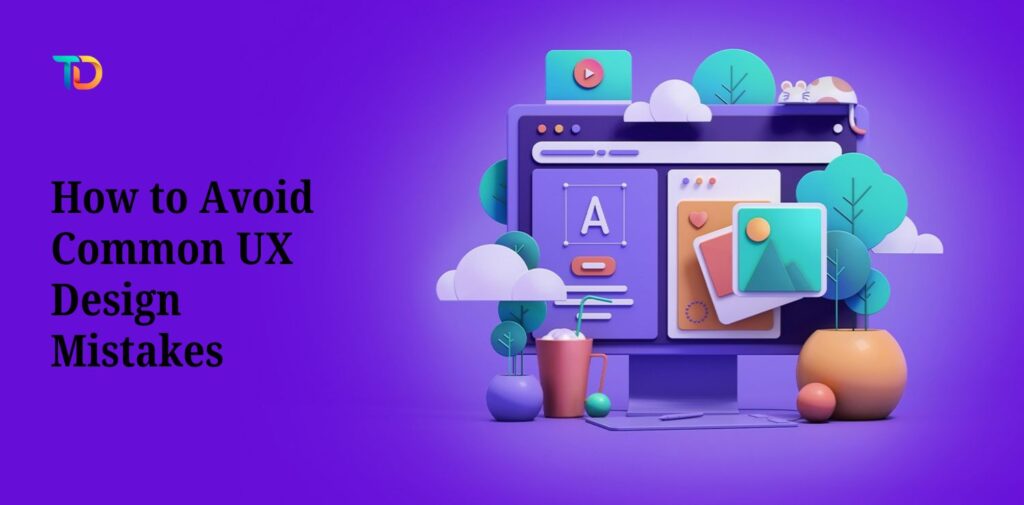User experience (UX) design is a crucial aspect of creating digital products that users enjoy and find easy to use. However, even experienced designers sometimes make mistakes that can negatively affect the usability and success of their designs. In this article, we’ll look at some of the most common UX design mistakes and how to avoid them.
1. Not Understanding the User’s Needs
One of the most critical mistakes a designer can make is failing to understand the target users. Without understanding your audience’s needs, preferences, and behaviors, you may create a product that doesn’t address their problems or provide value.
To avoid this mistake, invest time in user research. Conduct surveys, interviews, and usability tests to understand the challenges users face and how they would like the product to serve them. This insight will help you create designs that are truly user-centered and relevant.

2. Overcomplicating the Design
Simplicity is key in UX design. Overloading users with too many features, options, or information can confuse them and lead to frustration. A cluttered design can be difficult to navigate and may leave users feeling overwhelmed.
To prevent this, aim for a clean and simple design. Prioritize essential elements and focus on providing a seamless user journey. Keep your layout organized, with clear navigation and a minimalistic approach to content presentation. This will make the user experience smoother and more intuitive.
3. Ignoring Mobile Users
With an increasing number of people in India and around the world accessing the internet through smartphones, it’s essential that your design is mobile-friendly. Many designers still make the mistake of designing primarily for desktop users and neglecting mobile responsiveness. This can lead to poor user experiences for mobile users, which is a huge missed opportunity.
To avoid this, always design with mobile users in mind. Use responsive design principles so your product looks and works well on all screen sizes. Test your design on different devices to ensure that it provides an excellent experience on smartphones, tablets, and desktops.
4. Poor Navigation Design
Users should be able to find what they’re looking for quickly and easily. Poor navigation design, such as hidden menus, confusing labels, or unclear paths, can frustrate users and cause them to leave the site or app. A well-structured navigation system ensures that users can move through the product without confusion.
To improve navigation, keep it simple and consistent. Use clear labels for menu items, and make sure important pages are easily accessible. Consider using breadcrumbs or a search bar to help users find their way easily, and always test your navigation with real users.
5. Failing to Test the Design
One of the most overlooked steps in UX design is testing. It’s easy to get caught up in creating a visually appealing design, but without testing it with real users, you won’t know if it’s actually effective. Failing to test your design can result in missed issues that affect usability, which could have been easily fixed before the final product was launched.
Always conduct usability testing throughout the design process. This helps identify pain points, design flaws, and areas for improvement. By getting feedback from real users, you can make informed decisions and ensure your design is as user-friendly as possible.
6. Not Providing Clear Feedback to Users
Users need feedback when interacting with a product. Whether it’s clicking a button, submitting a form, or completing a task, users should always know what’s happening. If the design doesn’t provide adequate feedback, users may be left confused or unsure if their action was successful.
To solve this, make sure to provide clear visual cues when users interact with elements. For example, use loading indicators, success messages, or error notifications. This ensures that users always understand what’s happening and feel confident in using your product.
7. Disregarding Accessibility
Accessibility is often overlooked in UX design, but it’s essential to ensure that your product is usable by people with disabilities. This includes providing text alternatives for images, ensuring proper contrast for readability, and making sure your design works well with screen readers.

To avoid this mistake, follow accessibility guidelines such as the WCAG (Web Content Accessibility Guidelines). By designing with accessibility in mind, you make sure that your product is inclusive and accessible to a wider audience, including those with visual, auditory, or motor impairments.
Conclusion
Creating a great user experience requires careful attention to detail and a deep understanding of your users. By avoiding common mistakes such as neglecting user needs, overcomplicating the design, and failing to test, you can ensure your product is both functional and enjoyable to use. Always prioritize simplicity, test frequently, and keep the user at the center of your design process. By doing so, you’ll be on your way to creating products that provide a positive experience for all users.
